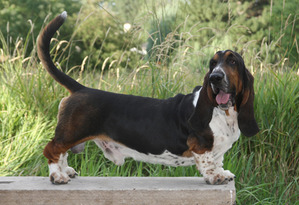 It’s hard not to smile when you see a short dog walking down the street. The jaunty gait of a Corgi or the silly lumber of a Basset Hound are qualities that have made those breeds popular for generations, and historically, the dogs’ short height helped them perform their jobs better (ankle-biting herding for the Corgi, and low-down tracking for the Basset).
It’s hard not to smile when you see a short dog walking down the street. The jaunty gait of a Corgi or the silly lumber of a Basset Hound are qualities that have made those breeds popular for generations, and historically, the dogs’ short height helped them perform their jobs better (ankle-biting herding for the Corgi, and low-down tracking for the Basset).
Something that is easily overlooked, however, is that this short-legged stance is – believe it or not – a bone disorder that has been selectively bred into dogs like Corgis and Bassets, not to mention Dachshunds, Dandie Dinmont Terriers, Skye terriers, Pekingese dogs, and other “low-riders” of the dog world. Furthermore, this mutation can occur in dog breeds that usually sport normal-length front legs.
Chondrodysplasia or osteochondrodysplasia literally means abnormal growth of the bone or cartilage. There are a few different versions of the disorder, and it can present differently in different breeds, so if you have specific questions about your dog’s health, you should talk to your vet. However, here are a few of the more common troubles drawf dogs encounter.
Arthritis in the front legs: One of the most noticeable features of a dwarf dog is the pronounced curvature of the front legs at the elbows and possibly the wrists. Dwarf dogs often have front legs that are shorter than their back legs, so the dog’s weight is pushed forward on these deformed, S-shaped legs. This can cause severe arthritis.
Disc disease: While a dwarf dog’s back is not necessarily long for its head size, it is the shortness of the legs that throw off the body’s proportion and make the back longer in ratio to the dog’s height. This lack of support from the legs can cause disc problems, which are inherent in Dachsunds, Basset Hounds, Corgis, and other dwarfed dogs.
Dental problems: Some dwarf dogs display an underbite and a crowded jaw, which can cause teeth to crowd into each other. This could necessitate dental surgery down the road to pull teeth that just don’t fit.
Cataracts: Both in dogs and humans, chondrodystrophy has been linked to cataracts. Rhosyn German Shepherd Dogs in Australia has a very informative website on the subject of chondrodystrophy, discussing how Havanese with crooked legs often have cataracts while those with straight legs do not; and furthermore, if a dog has one crooked leg and one straight leg, the eye on the same side as the crooked leg will develop a cataract, while the other eye does not.
One of the most important things you can do for your dog is to take care of its legs and spine. While dental issues and cataracts may or may not appear, you are virtually guaranteed to have a sore dog once the animal gets older.
When your dog is young, it will seem unflappable. However, you should still consider dog steps or ramps up to high furniture (if your dog, like ours, is allowed on the furniture). Jumping up may be easy, but when it comes time to get off, the THUMP when your dog hits the ground can be jarring to his front legs and spine. Once your dog gets older, it will appreciate that you facilitated him taking it easy on his joints!
Start feeding a joint supplement like Glucosamine – even better, get a supplement that contains Glucosamine, Chondroitin, and MSM together. These can build a shield against soreness in a younger dog and keep arthritis at bay in an older dog.
Skinny is where it’s at! Keep your dog as fit and trim as possible. The less weight it has to lug around, the better its joints will feel.
And, above all else, know your dog. If your dog is moving slowly, limping, seems stiff or tense, or doesn’t do the active things she used to do, it may be time to visit your vet – and to consider pain management like the Assisi Loop. Scores of veterinarians and pet owners have reported vast improvement in their dog’s pain levels thanks to the Assisi Loop, and it can be used anywhere on the body – so, if your dog’s spine is sore and her curved front legs are also causing a limp, both areas can be effectively treated by the Loop, as it did for Blake, one of our patient spotlights. Contact us or your veterinarian for more information.
If at any age, your dog starts acting lethargic or cries out in pain, and you suspect it could be related to its back, it’s vital that you contact your vet for guidance. Especially if your dog starts dragging the knuckles on its back feet or seems to have lost control of its urination and defecation, you could have a serious disc problem on your hands. Get your dog immobilized as quickly as possible (crate rest and total stillness, if possible), and call your vet or an emergency facility to get a neurological exam.
(And yes, all this can get expensive… But remember, many teaching vet hospitals perform top-notch services for a fraction of the cost of regular veterinarians, so consider a local teaching hospital if you have one nearby.)
Short dogs are lots of fun, and they are popular for a reason – it’s wonderful to watch their little legs as they prance around, and their personalities match their “different” appearance. But remember that any unique-looking dog will probably come with unique medical issues, so be prepared – and consider the Assisi Loop as part of your treatment protocol.

